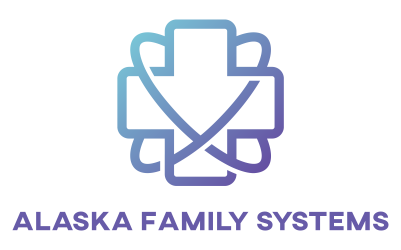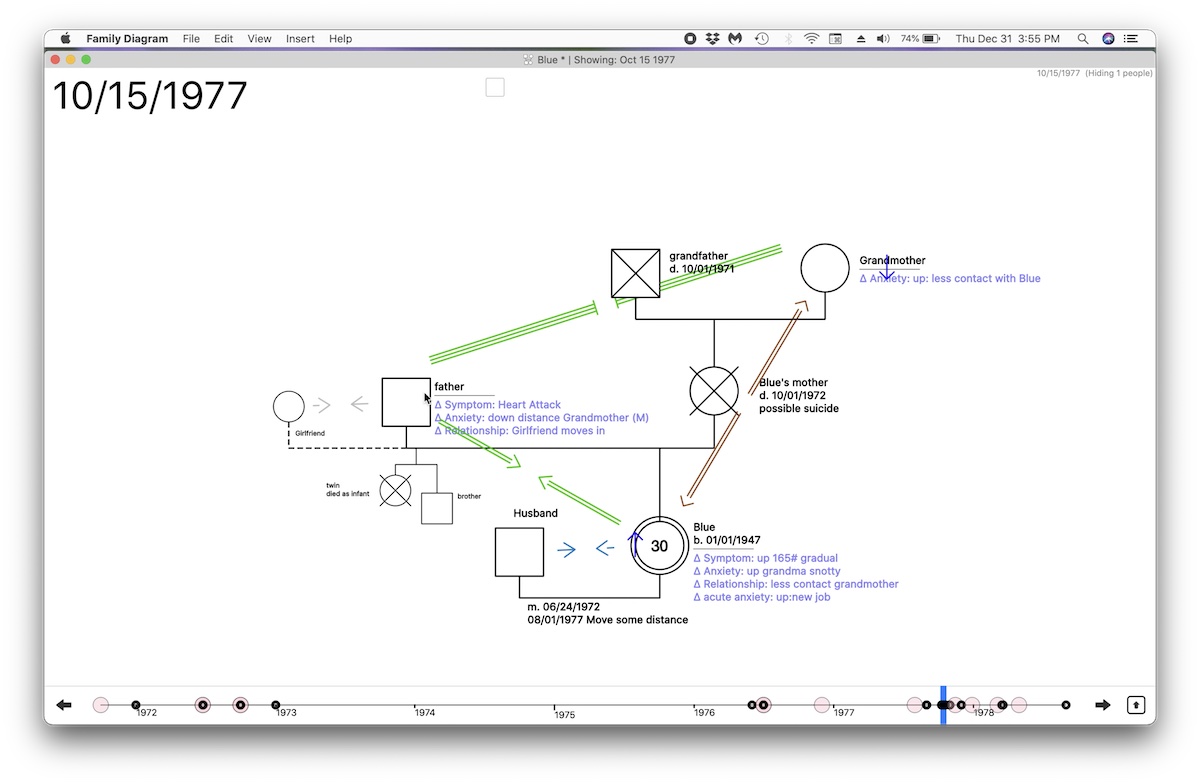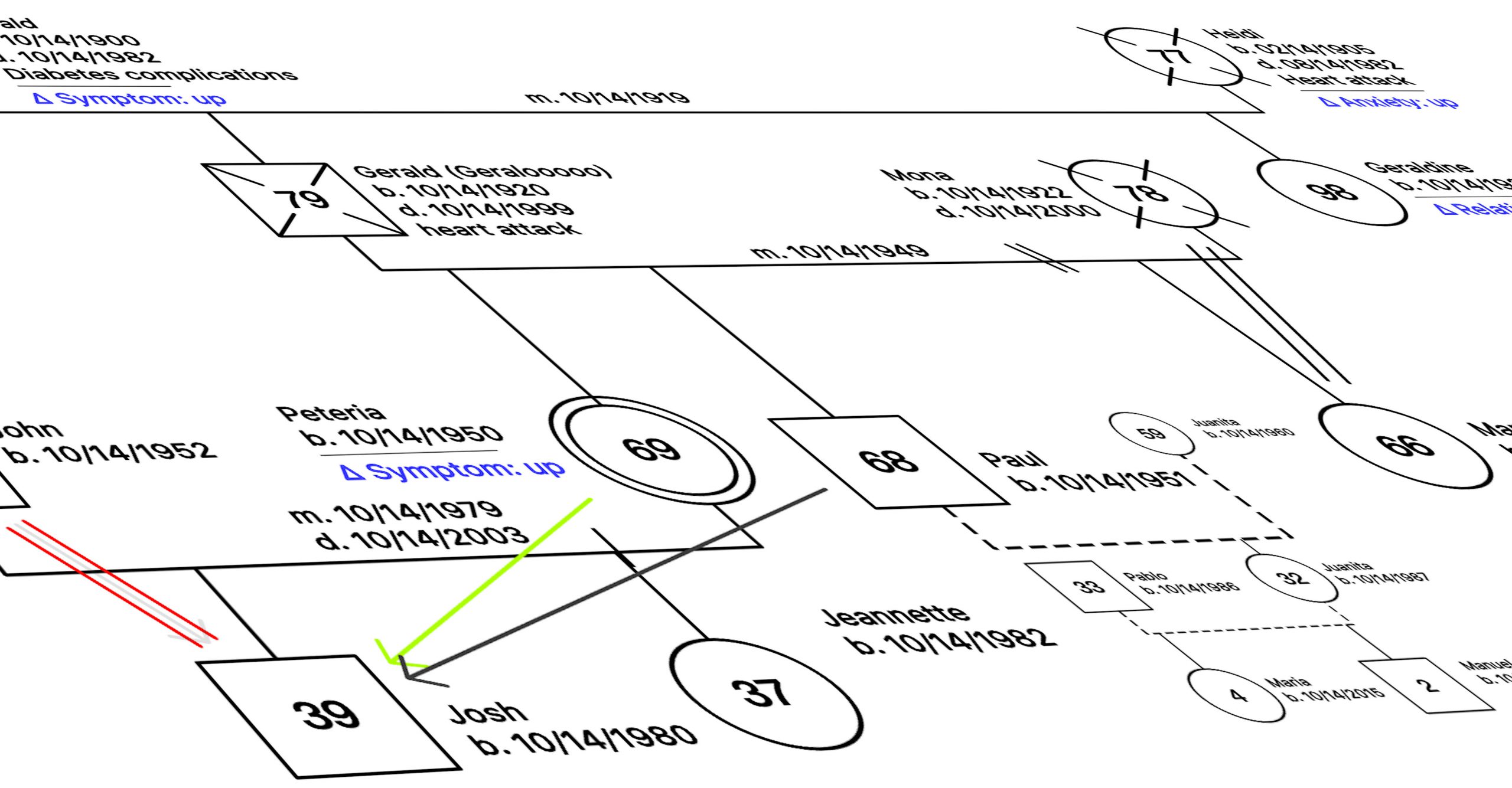This page serves as a collection for a list of example falsifiable hypotheses necessary to progress research under Bowen Theory. This page and its list of additional hypotheses will be constantly refined as new ideas are generated.
Falsifiable hypotheses are the universal requirement for accepted scientific experiments. The more subjective a set of ideas, the more difficult it is to generate falsifiable hypotheses from them. Ideas about human behavior are often so subjective that they cannot be falsified. These ideas are aptly called “not even wrong” (Woit, 2007). Love/hate, good/bad, soul/spirit, are all subjective ideas that are impossible to measure or test without the development of precise definitions.
So far as formal research goes, Bowen Theory remains no different. A review of available literature (Stinson, 2020) showed that there have currently been no falsifiable experiments that are 1) actually congruent with Bowen Theory, and 2) published in peer-review academic journals outside of the Bowen Network. No matter how small or how simple, any falsifiable experiment represents a contribution to the knowledge base behind Bowen Theory and the broader field of psychology as the study of human behavior.
Markers of a Falsifiable Hypothesis
- There is a clearly defined positive and negative result in the prediction.
- The hypothesis uses definitions that no one on the street would debate, i.e. the definitions are “factual.”
- OR: The hypothesis uses terms agreed upon by trained experts if no one on the street debates the outcome of the prediction is defined in terms no person would debate.
- Technology can be built around the reliability of the prediction (Technology repeatedly validates every hypothesis and every theory it depends on.)
The presence of technology that actually works probably is a slam-dunk validation of a hypothesis.
Two population-level waves of COVID infections where virtually all hospitalizations were unvaccinated people validates the theory and hypothesis of the RNA vaccine. The vaccine itself, the infrastructure to administer it, and any other tools built upon the assumption that the infrastructure works are examples of technology repeatedly validating the experimental hypothesis from the clinical trials. This population-level replication is the best evidence that can be found for a theory.
The fact that the entire civilized world, which is now most of the world, depends on mobile phones. The Every time a person picks up a mobile phone, they are replicating the original experiments run by the R&D departments of the phone developers. This is a population-level study on not just the hypotheses predicting the function of the software and hardware components, but all of the theories of electromagnetism, physical laws dictating the transmission and reception of audio signals, light, electricity, etc, and all laws underlying the technologies driving the infrastructure upon which that device is connected. This is as good as it gets for the validation of falsifiable prediction, where a hypothesis is tested a trillion-trillion times per second all across the world.
Theories of human behavior are nowhere near this level of precision. That is because we do not have the knowledge required to produce precise definitions which predict human behavior. That is understandable, as Homo sapiens studying himself is perhaps the ultimate scientific challenge. But that does not change the ultimate standard to which all science aspires – to produce explicit predictive models which by definition rely on falsifiable predictions.
List of Example Hypotheses
Inter-rater Reliability of Any Number of Specialized Terms
There have been no studies that establish inter-rater reliability for specialized terms (i.e. jargon) from Bowen Theory. Inter-rater reliability is required to demonstrate that a term has a definition precise enough for scientific research. Until a term has inter-rater reliability, it cannot be used to track data for a data model.
Examples of terms that are widely used but do not have demonstrated inter-rater reliability:
- Anxiety, Chronic
- Anxiety, Acute
- Functioning
- Open Contact
- Governed by self
- Self
- Governed by self
- Governed by system
- Inside of Triangle
- Outside of triangle
- Preferred position of triangle
- Separate more of a self
- Emotional fusion
- Stuck-togetherness
- and more…
An experiment to establish inter-rater reliability could be conducted for any one of these terms. Such studies are simple to organize and administer. Any difficulty will arise from the vagueness of the ideas themselves as opposed to a scientific methodology.
An experiment to test the inter-rater reliability of a term is easy to organize. You must compile a list of example uses of the term. The list must also include a number of example uses which appear similar to, but are not the term. You then give the list to a number of rater subjects who must identify which examples are and are not accurate representations of the term. Then then check and see whether the rater’s responses agree.
This kind of research is extremely important for Bowen theory as a science. It is not possibly to track data using a technical term until inter-rater reliability has been established for it. Until that occurs, formal scientific claims cannot be made referring to observations made using the term.
Definition of Anxiety (Inter-Rater Reliability)
The idea of anxiety is widely used in Bowen Theory. There currently exists no reliable way to identify increases and decreases in anxiety. This is the case both for acute shifts in anxiety or shifts that occur over longer periods of time.
An experiment would propose a definition for anxiety prior to the experiment, give some set of example shifts in anxiety up or down, and predict that there will be no notable agreement among a set of subjects asked to identify whether any shift occurred in each example, and if so when and whether the shift was up or down.
Some suggestions for definitions of anxiety would be an autonomic response that results in the subject rapidly searching for solutions to an urgent problem. This assumes that anxiety has something to do with a combination of increased anxiety and increased urgency. Finding a definition for acute anxiety may be easier than a definition for baseline (i.e. chronic) anxiety, because chronic anxiety is literally “normal” for a person and so is more out of view.
Some ideas for this are capture in this page: Improving The Definition of Anxiety. The working paper linked there – Anxiety as a Core Concept in Animal and Human Adaptation – offers more detailed ideas on a researchable definition.
Definition of Triangle (Inter-Rater Reliability)
On first glance, the idea of the “triangle” appears more objective than concepts from most clinical theories. A triangle has two positions: two on the inside, and one on the outside.
An experiment would define when a person was on the inside and outside of a triangle. The hypothesis would predict that there would be no notable agreement among independent subjects, trained or otherwise, in identifying the inside and outside positions of a triangle from various examples. Examples could be written narrative, audio, or video recordings.
Positions in a Triangle (Inter-Rater Reliability)
Once inter-rater reliability was established for the triangle concept, subsequent experiments could test the inter-rater reliability of shifts in the triangle configuration from a set of examples. The definition of a shift would be self-evident given the definitions of inside and outside positions. The hypothesis would predict that there would be no notable agreement between subjects, trained or otherwise, in identifying shifts in triangles from the examples. Examples could be written narrative, audio, or video recordings.
The Triangle Phenomenon
Once Inter-rater reliability was established for shifts in positions in a triangle, an experiment could test whether the triangle phenomenon itself actually exists as hypothesized. The existence of triangles are taken as so obvious that there as still been no formal research demonstrating that they actually exist. If triangles are as obvious as they are assumed to be then such research should be low-hanging fruit for a seminal contribution. If triangles are demonstrated to exist, such research could be cited as evidence for the part of an individual in a system that impacts that individual’s functioning.
At the most basic level, a shift to a preferred position in the triangle should result in a decrease in acute anxiety while a shift to an unpreferred position should result in an increase in acute anxiety. A hypothesis would predict that given a “sufficient” increase in tension in a dyad, one or the other person will take a desired an “inside” position either with the other person or with a third. If tension increases “sufficiently” further, one or the other person will seek a preferred “outside” position leaving the other two in an unpreferred inside position.
Examples would be demonstrated easily in the Family Diagram app with one Inside or Outside symbol per dyad in the triangle along with necessary shifts in a “Δ Anxiety” variable. Each shift in inside/outside position would include a start and end date-time of the position to visualize the change. The hypothesis would predict that each shift resulted in a shift in anxiety. A minimum sufficient sample of shifts in a single vignette for a single triangle might be 3. A sufficient sample size might be five vignettes, each from a different triad.
Sample vignettes from triads that did not show triangling must be included in the finding to avoid cherry picking data and provide a more accurate view of what necessitates “sufficient” anxiety for shifts in triangles.
Note that this hypothesis does not include the concept of differentiation of self. Ultimately, the concepts of the theory are interlocking/interdependent and cannot be separated from each other. However, in experimental research initial concessions can be made in order to move more systematically toward hard evidence for an increasing amount of the theory.
It is unclear as of this writing how one might design a falsifiable hypothesis for the triangle phenomenon while including differentiation of self. However, if the most basic aspect of the triangle is demonstrated to exist then subsequent speculation about how to account for variation in triangling would have higher quality data about triangles upon which to experiment.
Attachment Style and the Triangle
Attachment theory is the go-to theory in clinical psychology. It describes the development of a child’s relational pattern in terms of the two-person system of that child and their primary caregiver. It predicts the manner in which that child will respond to a particular anxiety-producing situation.
Bowen Theory describes a person’s response to anxiety in terms of that person’s functional position in their family system. The person is impacted most by their position in the primary triangle between mother and father, less in the triangle between sibling and parent, still less by triangles between extended family members, and still less by friends and professional contacts.
The triangle concept and hypothesis would predict that a person’s “attachment style” as defined by attachment theory would not predict all responses to anxiety when a third person is involved with the subject and primary caregiver. For example, an anxious-avoidant child may “present” with a disorganized attachment style when there is tension between the parents (Dallos, Lakus, Cahart, and McKenzie, 2016; Ross, A. S., Hinshaw, A. B., & Murdock, N. L., 2016).
If correct, this would support the notion that the family system plays as much a part in the response to anxiety as the nature of bond in the primary two-person system.
Conditions for the Selection of a Focused-On Child
The literature suggests that this is a kind of default anxiety binding mechanism for when the other mechanisms are insufficient to bind the anxiety/tension between the parents. Bowen’s own description of the selection process is quite open-ended. It lists some broad ideas for sufficient conditions but nothing testable. Examples are: sex of the child in relation to the family plan, sibling position, emotional climate and nuclear family configuration just prior to the birth of the child, and others.
There is no testable definition of the necessary conditions for two parents to select some child to be the focused-upon one. This means there is no proof that the phenomenon of child-focus exists. Further, there is no clear definition for the conditions sufficient to select one particular child.
A testable hypothesis would provide a definition for the conditions sufficient A) for the selection of some child and B) for which child would be selected. A null-hypothesis would predict that this definition yields no observable reliability across a sample of family cases where some child is assumed to be focused on.
In lieu of a testable definition of conditions for the selection of a focused-upon child, an open-ended exploratory experiment would define a limited set of family cases where there was assumed to be a focused upon child. It would gather observations about each case assumed to contribute to the selection of some child and more specifically the selection of one child in particular. Those patterns would then be incrementally tested and refined with other families until a degree of blind predictive power was achieved.
Well Differentiated Statements (Inter-rater Reliability)
Observations in Clinical Case Conferences reveal some implicit agreement on response to client statements that are well differentiated. Or conversely, statements that are undifferentiated. A research study could compile a list of such statements and their responses and measure agreement among people trained in Bowen theory as to whether each response is well-differentiated. Only providing a single response per vignette instead of an A/B test would aid in accurate responses.
Example 1 – Client: “My husband is overly punitive with our son.” Coach: “The punishment fits the crime.”
Example 2 – Client: “My mother has told me I never loved her even from birth, and that made me feel horrible.” “How many times a week does she say this?”
Example 3 – Client: “I am going to kill my neighbor.” Coach: “How sincere are you with this?” Client: “Very, I have a gun.” Coach: “I am so sorry, but as a mandated reporter I have to report this to the police.”
Subjects may rate some vignettes as n/a, or comment that they are written in a confusing manner. This is in itself an interesting finding, as a null result for an IIR study is just as useful as a positive or negative result.
Relationship Between Emotional Valence and Toward/Away, Inside/Outside, The Anxiety Binding Mechanisms
It is widely assumed in the field of research psychology that emotion has at least two major components: Intensity, and positive / negative “valence.” It also has a trajectory, but leave that aside for now. Valence is a binary value which indicates whether something is positive or negative. For emotion, valence is roughly equivalent to approach / avoid in Biology.
In data science, emotional valence is called “sentiment” and there are decent models that attempt to detect the sentiment in written word. While common intuition says that humans can easily detect emotional valence, the psychological literature finds that this turns out not to be the case. However, that does not mean that research cannot proceed assuming that it exists and can be detected. In fact, conceding that there will be some imprecision in coding what is positive versus negative emotion is in line with the degree of imprecision in Bowen theory as a whole.
The terms positive and negative emotion are implied in discussions on what Bowen theory calls “emotional process,” though the relationship between emotional valence to technical terms in theory has not been mapped out. Mapping it out would look like a simple table showing how a particular valence state, i.e. “positive” or “negative”, co-occurs with the known states of other terms like toward/away moves, inside/outside moves and/or positions, and use of the four anxiety binding mechanisms.
For example, it is clear that conflict is driven by negative emotion. Distance may also be driven by negative emotion. Overfunctioning / underfunctioning reciprocity may have a positive emotion component to it, though it may be driven by an initial impulse of negative emotion. In fact, it may be the case that all mechanisms are driven by initial negative emotion by definition, and are followed by either less negative emotion or even positive emotion as the mechanism reduces the experience of anxiety.
Further, a person can move toward another person with either positivity or negative emotion. The same applies to an away move. A person may move to the inside of a triangle with another person by either praising (positive emotion) or blaming (negative emotion) a third person.
Hypotheses on Emotional Valence and Theory
A qualitative research design would accumulate examples of emotional process that helped understand how valence relates to the terms in theory. Focus would be on moves which are the atomic operations of emotional process. Example null hypotheses are:
- That valence has no relationship with toward / away.
- That valence has no relationship with inside / outside.
- That there is no evidence for anxiety binding mechanisms always beginning with initial negative emotion, later followed by positive emotion as the mechanism causes anxiety to subside.
- And on and on.
A final product of such a research design would be a table or org chart proposing how positive and negative emotion occurs in relation to the above theoretical terms.
Baseline of Functioning
TODO: Definition and inter-rater reliability. Essential measurable for any clinical application.
Openness / Connectedness with Extended Family
TODO: Definition and Inter-rater reliability. Essential for Bowen Theory in particular.
Number of facts + certainty can name WRT family members: name, birth dates, birth locations, # of siblings. *potentially* use of subjective/objective points; depends on ability to distinguish between opinion & fact, i.e. “parsing”
Distinguishing Thinking VS Feeling
TODO: Definition and Inter-rater reliability. Essential for concept of differentiation of self. Also Related to Parsing
Systems Thinking
TODO: Definition and Inter-rater reliability.
Ability to “Parse” In Real Time
TODO: Definition and Inter-rater reliability. Related to separating thinking from feeling but more operationalized. Has to do with constructing a timeline, essential for understanding individual functioning let alone system functioning.
Submissions and/or Critique
Good science depends on good-faith critique and contribution. If you have any criticism or ideas for additional hypotheses, please feel free to submit them using the form below.
References
Dallos, R., Lakus, K., Cahart, M.S., & McKenzie, R. (2016). Becoming invisible: The effect of triangulation on children’s well-being. Clinical Child Psychology and Psychiatry, 21(3), 461–476.
Ross, A. S., Hinshaw, A. B., & Murdock, N. L. (2016). Integrating the relational matrix: Attachment style, differentiation of self, triangulation, and experiential avoidance. Contemporary Family Therapy, 38, 400–411.
Stinson, P. (2020). To What Extent did the Buddha Define a Natural System? Insights from Bowen’s Natural System Theory of the Family. California Institute of Integral Studies, San Francisco, CA.
Woit, P. (2007). Not Even Wrong: The Failure of String Theory and the Search for Unity in Physical Law for Unity in Physical Law. New York, NY: Basic Books.




